#james moll
Explore tagged Tumblr posts
Text

Frank De Felitta - The Entity - G.P. Putnam's Sons - 1978 (jacket design by The new Studio, cover illustration by James Moll)
#witches#entities#occult#vintage#the entity#g.p. putnam's sons#frank de felitta#novel#audrey rose#1978#the new studio#james moll
42 notes
·
View notes
Video
youtube
Black Sheep Boy, a short film by James Molle
26 notes
·
View notes
Text


the story of temple drake, stephen roberts 1933
#the story of temple drake#stephen roberts#1933#miriam hopkins#jack la rue#william gargan#william collier jr.#irving pichel#jobyna howland#guy standing#elizabeth patterson#florence eldridge#james eagles#harlan knight#james mason#louise beavers#arthur belasco#sanctuary#the long hot summer#light in august#romanze in moll#die dritte generation#eraserhead
1 note
·
View note
Text














RED AS...
anna james | angel silva | asmodeus moll | drew muller | halen price | icarus conford | ivy reyes | koa aroha | nellie dawson | otto james | poppy burton | royal woods | sasha antonova | sasha james
"red does not always signal danger and aggression. perhaps not surprisingly, red also symbolizes passion, love, and desire. red symbolizes energy, passion, strength, courage, physical activity, creativity, warmth, and security. it is also associated with aggression. In healing, use red to bring warmth and burn out disease."
#📖— the lore keeper#a. james#a. silva#a. moll#d. muller#h. price#i. conford#i. reyes#k. aroha#n. dawson#o. james#p. burton#r. woods#s. antonova#s. james
1 note
·
View note
Note
I would absolutely love to see examples of historical terminology? I feel like I've only scraped the surface.
So I'm going to focus mostly on 18th century English because that's what I read the most (we will dip a little into French but mostly from an English perspective). Even narrowing the focus there's still kind of a lot. Like I'm probably going to forget something cause there is so much to talk about.
Sexuality
The first thing that's important to understand is sexuality labels were action based not attraction based. This doesn't mean people didn't understand sexual attraction, they very much did, it's just that terminology was based on action not attraction. Terminology was essentially separated into men who have sex with men and women who have sex with women. It also important to remember that these terms were not exclusive to men who only had sex with men and women who only had sex with women but also applied to people who had sex with both men and women.
Men Who Had Sex With Men
Sodomy/Buggery
The terms most commonly used in formal/legal contexts were sodomite and bugger. Bugger comes from buggery and sodomite from sodomy, both of which broadly speaking referred to anal intercourse or bestiality regardless of sex/gender but was most commonly associated with sex between men. The legal definition of sodomy in English common law was as follows:
Sodomy is a carnal Knowledge of the Body of Man or Beast, against the Order of Nature; It way be committed by Man with Man, (which is the most common Crime) or Man with Woman; or by Man or Woman with a Brute Beast. Some Kind of Penetration and Emission is to be proved, to make this Crime, which is Felony both by the Common and Statute Law, in the Agent and all that a present, aiding and abetting; also in the Patient consenting, not being within the Age of Discretion.
~ The Student’s Companion or, the Reason of the Laws of England by Giles Jacob, 1734, p239
However colloquially it was generally used to describe sex between men without the focus on Penetration and Emission.
Related to sodomy were the words sodomitical, sodomitically and sodomiting, these terms were used to describe a person, action or place that was related to sodomy (esp. sex between men) but did not necessarily constitute legal sodomy. (for examples see Trial of Martin Mackintosh, 11 July 1726, A Treatise of Laws by Giles Jacob, 1721, p165 and Trial of Thomas Gordon, 5 July 1732 respectively)
From buggery we get the presumably derogatory term buggeranto. (for an example see The London Spy, part III, published 1703)
Molly
The preferred term used by the community was molly. Rictor Norton explains in Mother Clap’s Molly House:
The early church fathers stigmatised homosexuals as molls or sissies, and secular society called effeminate men molly-coddles and homosexuals mollies; having no other self-referring terms except the even less appealing Sodomite or Bugger, gay men transformed Molly into a term of positive self-identification, in exactly the same way that the modern subculture has transformed Gay (which derived originally from ‘gay girl’, meaning a female prostitute) into a term of pride and self-liberation.
Molly (plural mollies) was a noun:
Sukey Haws, being one Day in a pleasant Humour, inform’d Dalton of a Wedding (as they call it) some Time since, between Moll Irons, and another Molly,
~ James Dalton’s Narrative (1728)
Molly/mollied/mollying could also be a verb:
I was going down Fleet-Street, I was just come out of Jail. This Man, the Prosecutor, is as great a Villain as ever appear'd in the World. I was coming down Fleet-Street, so Molly says he; I said, I never mollied you. My Lord, I never laid my Hand upon him, nor touch'd him; I never touch'd the Man in my Life.
~ Trial of Richard Manning, (17 January 1746)
And mollying could be used as an adjective:
But they look'd a skew upon Mark Partridge, and call'd him a treacherous, blowing-up Mollying Bitch, and threatned that they'd Massacre any body that betray'd them.
~ Trial of Thomas Wright, (20 April 1726)
A molly house was house or tavern that catered to mollies. Molly houses would typically serve alcohol and often had music and dancing. Usually there was a room where mollies could have sex known as the chapel. (see Trial of Gabriel Lawrence, 20 April 1726 for an example of the term molly house in use, Trial of George Whytle, 20 April 1726 and Trial of Margaret Clap, 11 July 1726 for details on the chapel, and Trial of William Griffin, 20 April 1726 for molly houses taking lodgers.)
Mollies also had their own slang which I have a separate post on if you want to learn more about that.
Euphemisms
Euphemisms for men who had sex with other men included Back Gammon Player and Usher, or Gentleman of the Back Door. To navigate the windward passage was a euphemism for anal sex. (see The Classical Dictionary of the Vulgar Tongue, 1785.)
References to the classics were also sometimes used as euphemisms. A common example is Zeus's male lover Ganymede. (for an example see Public Advertiser, 4 Sept 1781)
Anal Sex Roles
The roles in anal sex were known as pathic (sometimes spelt Pathick) or patient (bottom) and agent (top). I have a longer post about the cultural perception of roles in anal sex if you're interested in that sort of thing.
Other Terms for Men Who Had Sex With Men
Pederast: In the 18th century the word pederasty was used synonymously with sodomy and did not denote age simply sex. An Universal Etymological English Dictionary (1726) defines “A pederast” as “a Buggerer” and “Pederasty” as “Buggery”.
Catamite: In particular catamite often, but not always, denoted the younger partner in a male-male sexual relationship. It was sometimes used to specifically describe boys but it was sometimes used it to describe men. Cocker's English Dictionary (1704) defines catamite as "a boy hired to be used contrary to nature, for Sodomy" but The New Royal and Universal English Dictionary (1763) defines catamite simply as "a sodomite." Catamite was also sometimes used as synonym for pathic.
Gomorrean: Like sodomite this one comes from the biblical story of Sodom and Gomorrah. However it wasn't nearly as commonly used. (for an example see The London Chronicle, 4 - 6 Jan 1757)
Madge Cull: This one came about towards the end of the century. It comes from a combination of Madge a slang term for “the female genitals” and Cull slang for “a man, a fellow, a chap.” (see Green’s Dictionary of Slang)
Women Who Had Sex With Women
Sodomy
While English common law did not consider sex between women sodomy this was not true across Europe. (see Louis Crompton, The Myth of Lesbian Impunity Capital Laws from 1270 to 1791) Most English colonies followed English common law however this aspect of the law was not unanimously agreed upon.
In 1636 Rev. John Cotton proposed to the General Court of Massachusetts a body of laws that would define sodomy as "a carnal fellowship of man with man, or woman with woman". (Crompton, p19)
In a 1779 bill submitted to the Virginia Assembly on crime and punishment Thomas Jefferson explicitly includes sex between women. He quotes Henry Finch's Law, or, a Discourse Thereof; in Four Books which defines sodomy as "carnal copulation against nature, to wit, of man or woman in the same sex, or of either of them with beasts." Jefferson disagrees with Finch on including bestiality because it "can never make any progress" and "cannot therefore be injurious to society in any great degree". However he doesn't dispute the inclusion of sex between women. He proposes that the punishment for sodomy be "if a man, by castration, if a woman, by cutting thro’ the cartilage of her nose a hole of one half inch diameter at the least." (see A Bill for Proportioning Crimes and Punishments in Cases Heretofore Capital, 18 June 1779)
While there was some disagreement on the legal definition of sodomy, colloquially if someone was talking about sodomy they were probably talking about sex between men. A clarification would likely be added if they were talking about women e.g. female sodomite.
Tribade
Coming from French tribade was defined in The New Pocket Dictionary of the French and English Languages (1781) as a "female sodomite". Tribade was used in English at least as early as 1585. It originally comes from the ancient Greek word τρίβειν meaning "rub" and is a reference to tribadism. The word tribadism however did not come into use until the 19th century. (see OED)
Sappho was a famous Tribade; as appears by the Testimonies of all the old Poets, but particularly from that beautiful Ode (addressed to one of the Ladies, with whom she was in Love) which Longinus has preserved, and which has ever been so highly esteemed by all the Critics.
~ William King, The Toast (1732)
Sapphic
Sapphic (sometimes spelt sapphick) originally meant "relating to, characteristic of, or reminiscent of Sappho or her writings". (OED) It became a term for sexual activity and sexual desire between women in reference of course to the accent Greek poet Sappho's love poems addressed to women. In fact in 18th century England Sappho was often cited as being the first woman who had ever had sex with another women.
Sappho, as she was one of the wittiest Women that ever the World bred, so she though with Reason, it would be expected she should make some Additions to a Science in which Womankind had been so successful: What dose she do then? Not content with our Sex, begins Amours with her own, and teaches the Female World a new Sort of Sin, call’d the Flats, that was follow’d not only in Lucian’s Time, but is practis’d frequently in Turkey, as well as at Twickenham at this day.
~ Satan’s Harvest Home (1749)
Sapphic is an adjective:
Look on that mountain of delight, Where grace and beauty doth unite, Where wreathed smiles must thrive; While Strawberry-hill at once doth prove, Taste, elegance, and Sapphick love, In gentle Kitty *****.
~ A Sapphick Epistle (1778)
Sapphism is a noun for the act or desire:
it has a Greek name now & is call’d Sapphism, but I never did hear of it in Italy where the Ladies are today exactly what Juvenal described them in his Time – neither better nor worse as I can find. Mrs Siddons has told me that her Sister was in personal Danger once from a female Fiend of this Sort; & I have no Reason to disbelieve the Assertion. Bath is a Cage of these unclean Birds I have a Notion, and London is a Sink for every Sin.
~ Hester Thrale Piozzi, Thraliana, 9 Dec 1795
Sapphist is a noun for the person:
Nature does get strangely out of Fashion sure enough: One hears of Things now, fit for the Pens of Petronius only, or Juvenal to record and satyrize: The Queen of France is at the Head of a Set of Monsters call’d by each other Sapphists, who boast her Example; and deserve to be thrown with the He Demons that haunt each other likewise, into Mount Vesuvius.
~ Hester Thrale Piozzi, Thraliana, 1 April 1789
Lesbian
Originally meaning "a native or inhabitant of the Greek island of Lesbos" (OED) this is another reference to Sappho who was from Lesbos.
However, this little Woman gave Myra more Pleasure than all the rest of her Lovers and Mistresses. She was therefore dignified with the Title of Chief of the Tribades or Lesbians.
~ William King, The Toast (1732)
Tommy
Tommy (plural tommies) is a fairly uniquely 18th century term as it doesn't seen to have been used earlier and is rarely used later. Speculatively it may be etymologically linked to tomboy which dates back to 1656. (OED)
Women and Men, in these unnat'ral Times, Are guilty equal of unnat'ral crimes: Woman with Woman act the Many Part, And kiss and press each other to the heart. Unnat'ral Crimes like these my Satire vex; I know a thousand Tommies 'mongst the Sex: And if they don't relinquish such a Crime, I'll give their Names to be the scoff of Time.
~ The Adulteress (1773)
Euphemisms
The game of flats, game at flats or simply flats was a euphemism for sex between women. Rictor Norton explains it was “a reference to games with playing cards, called ‘flats’, and an allusion to the rubbing together of two ‘flat’ female pudenda.” (Mother Clap’s Molly House, p233)
I am credibly informed, in order to render the Scheme of Iniquity still more extensive amongst us, a new and most abominable Vice has got footing among the W—n of Q—–y, by some call’d the Game at Flats;
~ Satan’s Harvest Home (1749)
In a diary entry Hester Thrale Piozzi repots "’tis a Joke in London now to say such a one visits Mrs. Darner". This was in reference to the rumours of sapphism that surrounded the sculptor Anne Damer. Piozzi goes on to recored a poem concerning Anne Damer's relationship with actress Elizabeth Farren that was being passed around her social circle:
Her little Stock of private Fame Will fall a Wreck to public Clamour, If Farren herds with her whose Name Approaches very near to Damn her.
~ Hester Thrale Piozzi, Thraliana, 9 Dec 1795 (see ‘Random Shafts of Malice?': The Outings of Anne Damer by Emma Donoghue for more on the rumours surrounding Anne Damer)
Absence of Sexual Attraction
With 18th century sexuality labels being action based rather than attraction based we have no exact equivalent for the word asexual. Just as we have no exact equivalent for the word homosexual. There was of course words for people who had never had sex (virgin, maiden) and words for people who planned on never having sex (celibate).
However this doesn't mean 18th century people had no way of talking about a lack of sexual attraction. The Chevalière d'Eon in a letter to the Comte de Broglie talks of "the natural lack of passion in my temperament, which has prevented my engaging in amorous intrigues”. Her lack of sexual interest became part of her self-styling as La Pucelle de Tonnerre (The Maiden of Tonnerre) after Joan of Arc who was known a La Pucelle d'Orléans (The Maiden of Orleans). (see D’Eon to the Comte de Broglie, 7 May 1771. Translated by Alfred Rieu, D'Eon de Beaumont, His Life and Times, p141; also for examples of the English press calling her La Pucelle d'Orléans see the Public Advertiser, 4 May & 11 June 1792)
The Third Sex/Gender
In the 18th century intersex people were predominantly referred to as hermaphrodites (while it is now considered offensive I will use it in this post as I think there is educational value in understanding it's historical use). In The Mysteries of Conjugal Love Reveal'd Written in French Nicholas de Venette explains that intersex people were permitted to "chuse either of the two Sexes". However if they strayed from the chosen role of man or woman they could be "punished like a Sodomite". (p465)
In the 18th century the words sex and gender were used somewhat synonymously. The word hermaphrodite along with third sex and third gender were used to describe not only intersex people but also gender nonconforming endosex people. Your clothes, interests, speech patterns and the way you move were all considered part of your sex.
Consider The Fribbleriad by David Garrick. Garrick was an actor known for playing fops. In the poem he portrays his critics as a group of effeminate men who were angry at him for they way he mocked them in his work:
In forty-eight— I well remember— Twelve years or more— the month November— May we no more such misery know! Since Garrick made OUR SEX a shew; And gave us up to such rude laughter, That few, ‘twas said, could hold their water: For He, that play'r, so mock’d our motions, Our dress, amusements, fancies, notions, So lisp’d our words and minc’d our steps, He made us pass for demi-reps. Tho’ wisely then we laugh’d it off, We’ll now return his wicked scoff.
"OUR SEX" is understood to be the sex of effeminate men. A sex distinct from that of acceptable manhood or womanhood which is defined by their "dress, amusements, fancies, notions" as well as the way they "lisp'd" their words and "minc’d" their steps.
John Bennett in his popular conduct book Letters to a Young Lady on a Variety of Useful and Interesting Subjects advises young women against wearing riding habits warning that they would "wholly unsex her". The Guardian reports that some people had "not injudiciously stiled" the riding Habit "Hermaphroditical". And The Spectator complains about riding Habits calling them an "Amphibious Dress" and describing women who wear them as "Hermaphrodites" and a "Mixture of two Sexes in one Person". (The Guardian, 1 September 1713, reprinted in The Guardian edited by John Calhoun Stephens, p 486; The Spectator 19 July, 1712)
The word amphibious is one that comes up a lot in the 18th century in regards to gender. A dictionary of the English language (1794) defines amphibious as "living in two elements". John Bennett describes effeminate men as "poor amphibious animals, that the best naturalists know not under what class to arrange."
Alexander Pope famously called Lord Hervey an "Amphibious Thing!" that acts "either Part". Lady Mary Wortley Montagu said that "this world consisted of men, women, and Herveys". And William Pulteney describes him as "delicate Hermaphodite", "a pretty, little, Master-Miss" and "a Lady Himself; or at least such a nice Composition of the two Sexes, that it is difficult to distinguish which is most predominant." (Alexander Pope, Epistle to Dr Arbuthnot; The Letters and Works of Lady Mary Wortley Montagu edited by Lord Wharncliffe, v1, p95; William Pulteney, A Proper Reply To a late Scurrilous Libel)
Macaroni, amazon, virago, fop, petit-maitre, coxcomb, amphibious, unsex, dandy, namby-pamby, he-she things, lady-fellow, master-miss, fribble, dubious gender. These were all terms to describe gender nonconforming people. Many of these terms were used in a derogatory way but not all of them were intended as such and some GNC people identified with some of these terms. For example a young Charles James Fox described himself as a petit-maitre in his 18 Oct, 1763 letter to his father. While at Eton, which he found "more disagreeable than I imagined", he laments "you may see the petit maître de Paris is converted into an Oxford Pedant."
Many of the people who were labeled as third sex/gender would not necessarily have identified as such. With even the smallest deviation from the norm giving rise to the label. Including one 1737 article which claimed that "Ugly Women" may "more properly be call'd a Third Sex, than a Part of the Fair one". (Common Sense, or The Englishman's Journal, 28, Feb)
Gender Presentation Through Gendered Language
While there is no real equivalent for the word transgender in 18th century English this doesn't mean people had no way of expressing their gender though language. People referred to themselves as being men, women, both or neither. Gendered names, titles and pronouns were also used to express one's gender.
The Chevalière d'Eon
D'Eon asserted her gender identity though gendered names, pronouns and titles. When she started openly living as a women she changed her first name to Charlotte making her full name Charlotte-Geneviève-Louise-Auguste-André-Timothée d’Eon de Beaumont. However she preferred the name Geneviève and would often write her name simply Geneviève d'Eon.

[Admission-ticket for Geneviéve d'Eon, with red seal; c.1793; via The British Museum (C,2.3)]
D'Eon used she/her pronouns. Here is an example of her using she/her pronouns for herself when writing in third person:

[Invitation from the Chevalière d’Eon to Lord Besborough; c.1791; via The British Museum (D,1.268-272)]
As she was French d'Eon used French titles even in English. She would sometimes use the title Mademoiselle (a title for unmarried women) but other times she used Chevalière. In 1763 she was awarded the Cross of Saint-Louis and with that came the masculine title Chevalier. When she started openly living as a women she switched from the masculine Chevalier to the feminine Chevalière. Perhaps the most fun example of her using the feminine Chevalière is the sword she gifted to George Keate which was inscribed: "Donné par la Chevalïere d’Eon à son ancïen Amï Geo: Keate Esquïre. 1777"


[The Chevalière d’Eon’s Sword, hilt: c.1700s, blade: c.mid-1600s, inscription: c.1777, photos via the Royal Armouries Museum (IX.2034A)]
Public Universal Friend
The Public Universal Friend claimed to be a genderless spirit sent by god resurrected in the body of Jemima Wilkinson after she had succumbed to a fever in 1776. The Public Universal Friend gained a small but devoted group of followers that understood and respected the Friend as a genderless being. When one traveler asked for directions to "Jemima Wilkinson's house" a women replied that "she knew no such person; "the friend" lived a little piece below." (A Ride to Niagara in 1809 by Cooper Thomas, p37)
For the most part followers of the Public Universal Friend avoided using gendered pronouns for the Friend*. However they did not use gender neutral pronouns (such as they/them) but instead avoided third person pronouns completely. You can see an example of the sort of gender neutral language used for the friend in this letter from Sarah Richards to Ruth Pritchard:
Dear Ruth This is to be a Messenger of my Love to thee. Hold out faith and patience. Thy letter was very welcome to me. I want Thee should make ready to come where the Friend is in this Town. The Friend has got land enough here for all that will be faithful & true. Dear Ruth, I will inform thee that Benedict has given the Friend a Deed of some land in the second Seventh in the Boston perhemption, which Deed contains five lotts and the Friend has made use of my name to hold it in trust for the Friend, and now I hope the Friends will have a home, and like wise for the poor friends and such as have no helper, here no intruding feet cant enter. Farewell form thy Affectionate Friend, Sarah Richards
~ Sarah Richards to Ruth Pritchard, March 1793 (printed in The Unquiet World by Frances Dumas, p166)
* In contrast to followers that avoided gendered pronouns completely ex-follower Abner Brownell claimed that some followers called the Friend "him." (see A Mighty Baptism edited by Susan Juster & Lisa MacFarlane, p28)
It's impossible to seperate the Friend's genderlessness from the claim that the Friend was a messenger sent by god resurrected in the body of Jemima Wilkinson. The followers of the Public Universal Friend used genderless language as a way to indicate their religious devotion. In "Indescribable Being" Theological Performances of Genderlessness in the Society of the Publick Universal Friend, 1776-1819 Scott Larson explains:
The language one chose to describe the Friend indicated whether one was part of the community of the saved or part of the "wicked world." Conversely, community members and followers used the name "the Friend" quite deliberately, and that use became a marker of belonging. This sense of belonging could last longer than the community itself did. Huldah Davis, who was a child when the Friend left time in 1819, shared her memories of the Friend in 1895. In her recollections, Davis refers to Jemima Wilkinson but is careful to note that her parents, followers of the Friend, always referred to "the Friend," and Davis uses the community's language through most of her account. Language choices could also mark points of entering and exiting the community, as the apostate and denouncer Abner Brownell refers to "The Friend" in diary entries written during the time of his membership in the Friend's community but then calls "her" "Jemima Wilkinson" in his later published denunciation, Enthusiastical Errors, Described and Decried.
Mollies and Maiden Names
Gendered language could be used to express queer identity without necessarily expressing a transgender identity. Mollies took on feminine sobriquets known as maiden names. A maiden name was a typically made up of a combination of either a feminine title or name (molly and variations being the most popular) and often a reference to something notable about the individual. It could be a reference to their profession for example Orange Mary was an orange merchant, Dip-Candle Mary was a tallow chandler and Old Fish Hannah a fisherman. It could be a reference to where they were from for example Mrs. Girl of Redriff was presumably from Redriff. Some maiden names were somewhat suggestive like Miss Sweet Lips or Molly Soft-buttocks.
(Sources for maiden names: Orange Mary, Dip-Candle Mary, Old Fish Hannah, and Mrs. Girl of Redriff are mentioned in James Dalton's Narrative; Miss Sweet Lips is mentioned in The Phoenix of Sodom by Robert Holloway; Molly Soft-buttocks is mentioned in Account of the Life and Actions of Joseph Powis)
While mollies took on these feminine names, they more often than not still lived as men. Most mollies wore men's clothes, used he/him pronouns and referred to their partners as their husbands not their wives. (for the use of husband in the molly subculture see the trial of Martin Mackintosh, 11 July 1726 and the trial of George Whytle, 20 April 1726)
However some mollies did wear women's clothes and used (at least some of the time) feminine pronouns. Take for example Princess Seraphina who during the trial of Thomas Gordon (5 July 1732) is described by Mary Poplet as follows:
I have known her Highness a pretty while, she us’d to come to my House from Mr. Tull, to enquire after some Gentlemen of no very good Character; I have seen her several times in Women’s Cloaths, she commonly us’d to wear a white Gown, and a scarlet Cloak, with her Hair frizzled and curl’d all round her Forehead; and then she would so flutter her Fan, and make such fine Curties, that you would not have known her from a Woman: She takes great Delight in Balls and Masquerades, and always chuses to appear at them in a Female Dress, that she may have the Satisfaction of dancing with fine Gentlemen. Her Highness lives with Mr. Tull in Eagle-Court in the Strand, and calls him her Master, because she was Nurse to him and his Wife when they were both in a Salivation; but the Princess is rather Mr. Tull’s Friend, than his domestick Servant. I never heard that she had any other Name than the Princess Sraphina.
On a final note I would also recommend looking up many of these terms in the Oxford English Dictionary (you might be able to access this for free through your library) and Green's Dictionary of Slang both of which include multiple examples in use.
#sorry this took so long I couldn't resist making it far too long#if you want me to talk your ear off just ask me about 18th century queer language its my favourite topic#queer history
149 notes
·
View notes
Photo
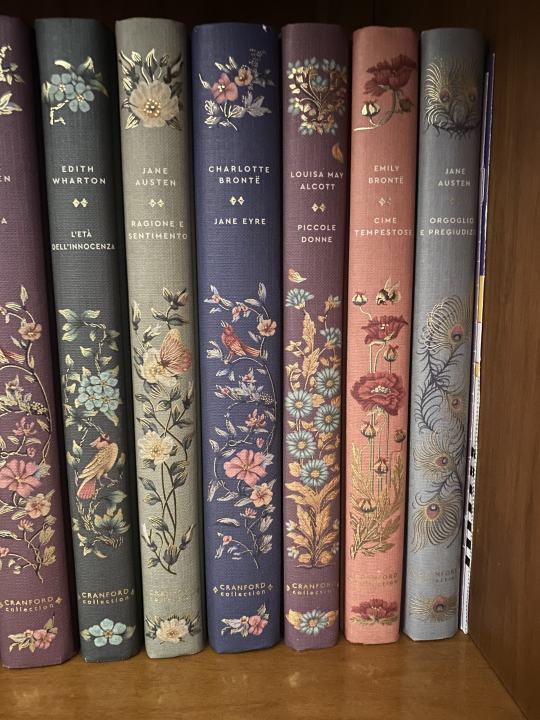
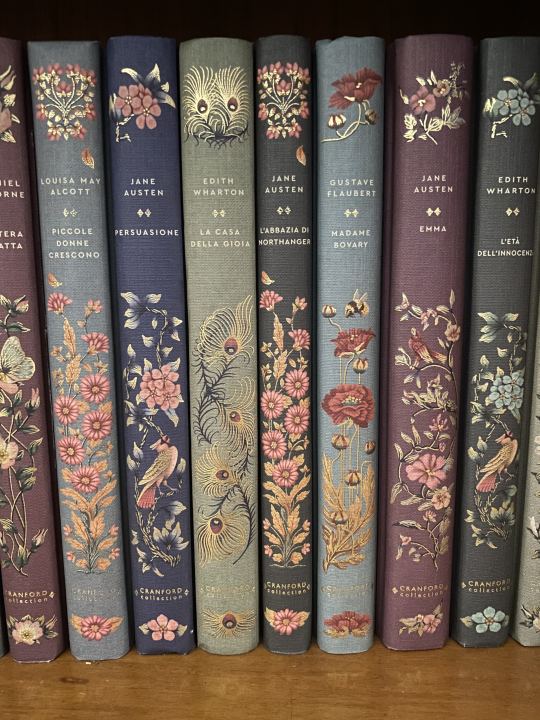
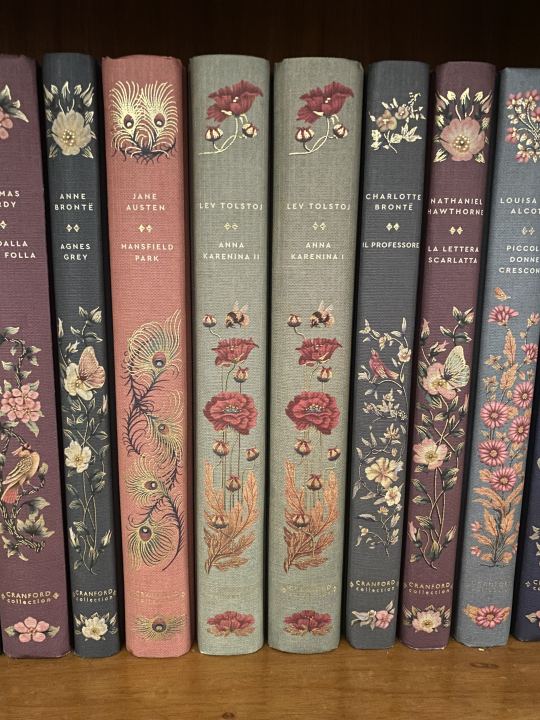

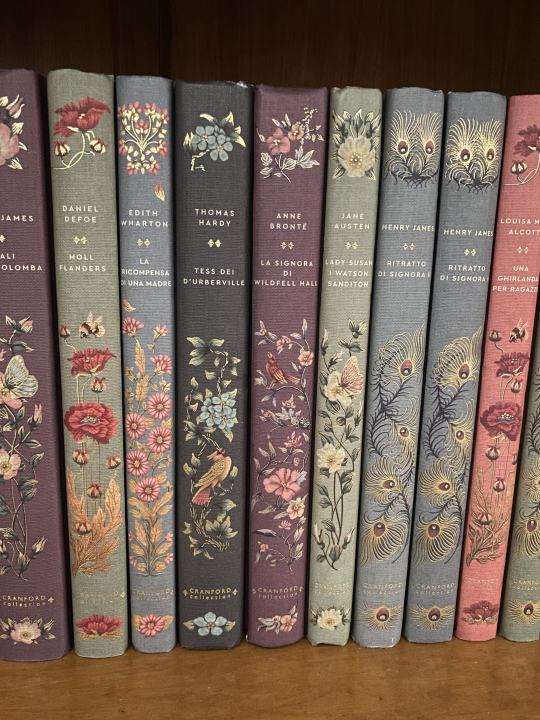
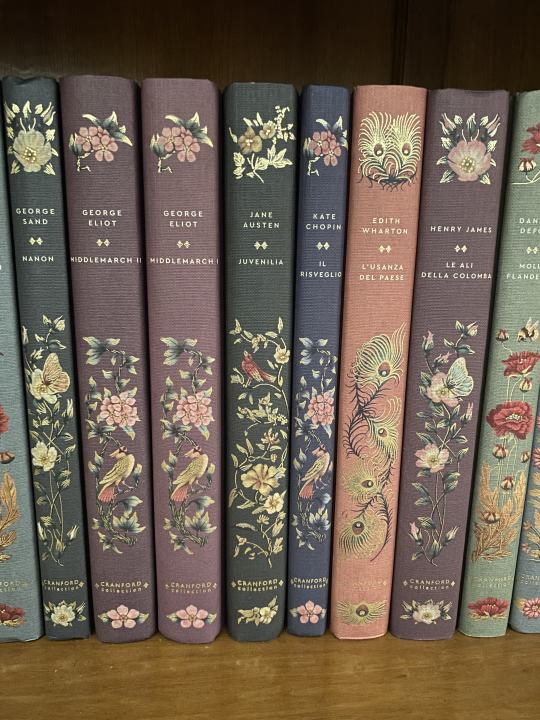


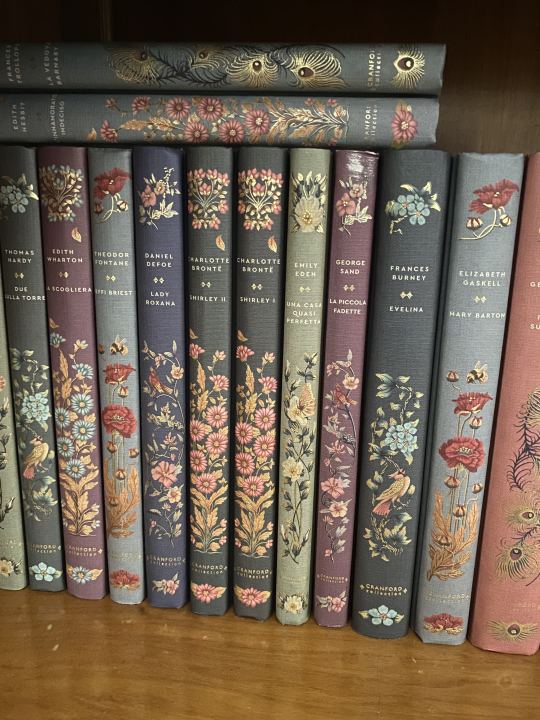

My book collection so far
Jane Austen - Pride and Prejudice
Emily Bronte - Wuthering Heights
Louisa May Alcott - Little Women
Charlotte Bronte - Jane Eyre
Jane Austen - Sense and Sensibility
Edith Wharton - The Age Of Innocence
Jane Austen - Emma
Gustave Flaubert - Madame Bovary
Jane Austen - Northanger Abbey
Edith Wharton - The House of Mirth
Jane Austen - Persuasion
Louisa May Alcott - Good Wives
Nathaniel Hawthorne - The Scarlet Letter
Charlotte Bronte - The Professor
Leo Tolstoy - Anna Karenina (Part 1)
Leo Tolstoy - Anna Karenina (Part 2)
Jane Austen - Mansfield Park
Anne Bronte - Agnes Grey
Thomas Hardy - Far from The Madding Crowd
William Makepeace Thackeray - Vanity Fair (Part 1)
William Makepeace Thackeray - Vanity Fair (Part 2)
Pierre-Ambroise-François Choderlos de Laclos - Dangerous Liaisons
Alexandre Dumas fils - The Lady of the Camellias
Henry James - Washington Square
Louisa May Alcott - A Garland For Girls
Henry James - The Portrait of A Lady (Part 1)
Henry James - The Portrait of A Lady (Part 2)
Jane Austen - Lady Susan. The Watson. Sanditon
Anne Brontë - The Tenant of Wildfell Hall
Thomas Hardy - Tess of the D’Urbeville
Edith Wharton - The Mother’s Recompense
Daniel Defoe - Moll Flanders
Henry James - The Wings of the Dove
Edith Wharton - The Customs of the Country
Kate Chopin - The Awakening
Jane Austen - Juvenilia
George Eliot - Middlemarch (Part 1)
George Eliot - Middlemarch (Part 2)
George Sand - Nanon
Henry James - The Ambassadors
Elizabeth Gaskell - Cranford
Thomas Hardy - Under The Greenwood Tree
Edith Wharton - Summer
George Sand - Indiana
Henry James - The Bostonians
George Eliot - Silas Marner
Henry James - The Golden Bowl (Part 1)
Henry James - The Golden Bowl (Part 2)
Edith Wharton - The Twilight Sleep
Emily Eden - The Semi-Attached Couple
Edith Wharton - The Glimpses of the Moon
Mary Elizabeth Braddon - Lady Audley’s Secret
George Eliot - The Mill on the Floss
Elizabeth Gaskell - Mary Barton
Fanny Burney - Evelina
George Sand - Little Fadette
Emily Eden - The Semi-detached House
Charlotte Brontë - Shirley I
Charlotte Brontë - Shirley II
Daniel Defoe - Lady Roxana
Theodor Fontane - Effie Briest
Edith Wharton - The Cliff
Thomas Hardy - Two on a Tower
Frances Hodgson Burnett - A Lady of Quality
Louisa May Alcott - Moods
Edith Nesbit - The Incomplete Amorist
Frances Trollope - The Widow Barnaby (Part 1)
#storie senza tempo#books#book collection#classical literature#literature#american literature#german literature#english literature#french literature#jane austen#russian literature#pride and prejudice#emma#sense and sensibility#edith wharton#lady roxana#moll flanders#anna karenina#lev tolstoy#bronte sisters#jane eyre#wuthering heights#the age of innocence#little women#louisa may alcott#timeless classics#romans eternels#novelas eternas#middlemarch#george eliot
281 notes
·
View notes
Text
List of Half Foot inspired* prefixes and suffixes, excluding surnames
*based on my basic understanding of the naming convention. and also the canon ones :p
All under the cut, its a long list. Also some fun full names that could TECHNICALLY be half foot names
Feel free to comment/reblog with your own!
prefixes
puck
mel
trill
tam
nim
mep
mag
may
fler
fleur
mei
chil
chip
eve
rev
rue
roan
zap
gar
tick
rass
thack
keg
fritz
chock
mund
pitch
snif
nit
huck
dell
flynn
good
kish
kipp
kipper
bix
binx
skip
maze
jive
dan
clem
soot
kemp
moll
bram
brom
pip
zip
merry
scot
suffixes
jack
eve
nick
james
my
kash
bea
lynn
lee
ash
dot
patch
jona
aster
luke
joy
ive
bill
bert
blue
breck
flynn
hyde
jame
jo
lewis
merle
mirl
maud
vic
vick
dan
murph
duke
jove
beck
frank
lark
gale
link
dell
sue
lou
patti
tom
chuck
ness
dave
don
tim
john
jake
beth
lisa
liza
bob
rob
mitch
pete
ian
bonus names
rhettlink (i mean come on)
charlee bigs
aliceyn chains
nicknack
kipperlily (i mean its RIGHT there)
bugsnax (listen.)
grandpa cheez
petzig
timney
lugnut torks
timhor tons
slimjim
#dungeon meshi#delicious in dungeon#half foot#ryoko kui#half foot names#dm oc#dungeon meshi ocs#half foot dungeon meshi#dunmeshi#dunmeshi names
44 notes
·
View notes
Text
The End of the Gentleman Pirate - Stede Bonnet
For the best part of the year 1717, Stede Bonnet, dubbed The Gentleman Pirate, had operated alongside Blackbeard. Eventually, though, Blackbeard double- crossed him, and sailed off with the plunder. Bonnet then hunted alone, and in the late summer of 1718 he entered the Cape Fear River to repair his sloop, the Royal James.

The surrender of Bonnet (x)
Around that time two pirate- hunting sloops under the command of Colonel William Rhett left Charleston, South Carolina. On the evening of 26 September the Henry and the Sea Nymph approached the mouth of the Cape Fear River, where they spotted Bonnet's sloop. It was already growing dark, so they blockaded the river, and prepared for a battle the next morning.

A 1733 map of Charleston by Herman Moll (x)
Bonnet was outnumbered, so his big hope was to surprise the enemy, race past them with guns blazing, and head for the open sea. However, just as the Royal James came within range of the two pirate hunter she ran hard aground on a sandbank. Then, when the Henry and the Sea Nymph moved in for the kill, they both ran aground as well. All three ships were stranded within musket range of each other, exchanging fire while waiting for the tide to come in. This strange battle lasted for five hours, but it was the Henry which was the first to float free. With her guns threatening to sweep the decks of the Royal James, Bonnet had little choice but to surrender.

The tryals of Major Stede Bonnet and other pirates viz. Printed for Benj. Cowse ..., 1719 (x)
He was then taken to Charleston, pleaded not guilty, claiming his men had forced him to act as a pirate against his will 13 times but Bonnet was hanged along with 29 men.
#naval history#stede bonnet#the last fight#26/27 september 1718#pirates#requested by a friend#age of sail
157 notes
·
View notes
Text
Opera on YouTube
I've shared links to complete opera performances before, but I love to share them, so I thought I'd make a few masterposts.
These list are by no means the only complete filmed performances of these operas on YouTube, but I decided that ten links for each opera was enough for now.
By the way, some of the subtitles are just a part of the video, while others require you to click CC to see them.
Die Zauberflöte (The Magic Flute)
Hamburg Philharmonic State Opera, 1971 (Nicolai Gedda, Edith Mathis, William Workman, Christina Deutekom, Hans Sotin; conducted by Horst Stein; English subtitles)
Ingmar Bergman film, 1975 (Josef Köstlinger, Irma Urrila, Håkan Hagegård, Birgit Nordin, Ulrik Cold; conducted by Eric Ericson; sung in Swedish; English subtitles)
Salzburg Festival, 1982 (Peter Schreier, Ileana Cotrubas, Christian Bösch, Edita Gruberova, Martti Talvela; conducted by James Levine; Japanese subtitles)
Bavarian State Opera, 1983 (Francisco Araiza, Lucia Popp, Wolfgang Brendel, Edita Gruberova, Kurt Moll; conducted by Wolfgang Sawallisch; English subtitles)
Metropolitan Opera, 1991 (Francisco Araiza, Kathleen Battle, Manfred Hemm, Luciana Serra, Kurt Moll; conducted by James Levine; English subtitles)
Paris Opera, 2001 (Piotr Beczala, Dorothea Röschmann, Detlef Roth, Desirée Rancatore, Matti Salminen; conducted by Ivan Fischer; no subtitles)
Royal Opera House, Covent Garden, 2003 (Will Hartman, Dorothea Röschmann, Simon Keenlyside, Diana Damrau, Franz Josef Selig; conducted by Colin Davis; no subtitles) – Act I, Act II
La Monnaie, Brussels, 2005 (Topi Lehtipuu, Sophie Karthäuser, Stephan Loger, Ana Camelia Stefanescu, Harry Peeters; conducted by René Jacobs; French subtitles)
Kenneth Branagh film, 2006 (Joseph Kaiser, Amy Carson, Benjamin Jay Davis, Lyubov Petrova, René Pape; conducted by James Conlon; sung in English)
San Francisco Opera, 2010 (Piotr Beczala, Dina Kuznetsoca, Christopher Maltman, Erika Miklósa, Georg Zeppenfeld; conducted by Donald Runnicles; English subtitles)
La Traviata
Mario Lanfrachi studio film, 1968 (Anna Moffo, Franco Bonisolli, Gino Bechi; conducted by Giuseppe Patané; English subtitles)
Glyndebourne Festival Opera, 1987 (Marie McLaughlin, Walter MacNeil, Brent Ellis; conducted by Bernard Haitink; Italian and Portuguese subtitles)
Teatro alla Scala, 1992 (Tiziana Fabbricini, Roberto Alagna, Paolo Coni; conducted by Riccardo Muti; English subtitles)
Royal Opera House, Covent Garden, 1994 (Angela Gheorghiu, Frank Lopardo, Leo Nucci; conducted by Georg Solti; Spanish subtitles)
Teatro Giuseppe Verdi, 2003 (Stefania Bonfadelli, Scott Piper, Renato Bruson; conducted by Plácido Domingo; Spanish subtitles)
Salzburg Festival, 2005 (Anna Netrebko, Rolando Villazón, Thomas Hampson; conducted by Carlo Rizzi; no subtitles)
Los Angeles Opera, 2006 (Renée Fleming, Rolando Villazón, Renato Bruson; conducted by James Conlon; English subtitles)
Opera Festival St. Margarethen, 2008 (Kristiane Kaiser, Jean-Francois Borras, Georg Tichy; conducted by Ernst Märzendorfer; English subtitles)
Teatro Real di Madrid, 2015 (Ermonela Jaho, Francesco Demuro, Juan Jesús Rodríguez; conducted by Renato Palumbo; English subtitles)
Teatro Massimo, 2023 (Nino Machiadze, Saimir Pirgu, Roberto Frontali; conducted by Carlo Goldstein; no subtitles)
Carmen
Herbert von Karajan studio film, 1967 (Grace Bumbry, Jon Vickers; conducted by Herbert von Karajan; English subtitles)
Vienna State Opera, 1978 (Elena Obraztsova, Plácido Domingo; conducted by Carlos Kleiber; English Subtitles)
Francisco Rosi film, 1982 (Julia Migenes, Plácido Domingo; conducted by Lorin Maazel; English subtitles)
Metropolitan Opera, 1987 (Agnes Baltsa, José Carreras; conducted by James Levine; English subtitles)
London Earls Court Arena, 1989 (Maria Ewing, Jacque Trussel; conducted by Jaques Delacote; English subtitles)
Royal Opera House, Covent Garden, 1991 (Maria Ewing, Luis Lima; conducted by Zubin Mehta; English subtitles) – Acts I and II, Acts III and IV
Arena di Verona, 2003 (Marina Domashenko, Marco Berti; conducted by Alain Lombard; Italian subtitles)
Royal Opera House, Covent Garden, 2006 (Anna Caterina Antonacci, Jonas Kaufmann; conducted by Antonio Pappano; English subtitles) – Acts I and II, Acts III and IV
Metropolitan Opera, 2010 (Elina Garanca, Roberto Alagna; conducted by Yannick Nézet-Séguin; English subtitles) – Acts I and II, Acts III and IV
Opéra-Comique, 2023 (Gaëlle Arquez, Frédéric Antoun; conducted by Louis Langrée; English subtitles)
La Bohéme
Franco Zeffirelli studio film, 1965 (Mirella Freni, Gianni Raimondi; conducted by Herbert von Karajan; English subtitles)
Metropolitan Opera, 1977 (Renata Scotto, Luciano Pavarotti; conducted by James Levine; no subtitles)
Teatro alla Scala, 1979 (Ileana Cotrubas, Luciano Pavarotti; conducted by Carlos Kleiber; no subtitles)
Opera Australia, 1993 (Cheryl Barker, David Hobson; conducted by Julian Smith; Brazilian Portuguese subtitles)
Teatro Regio di Torino, 1996 (Mirella Freni, Luciano Pavarotti; conducted by Daniel Oren; Italian subtitles)
Teatro alla Scala, 2003 (Cristina Gallardo-Domâs, Marcelo Alvarez; conducted by Bruno Bartoletti; Spanish subtitles)
Zürich Opera House, 2005 (Cristina Gallardo-Domâs, Marcello Giordani; conducted by Franz Welser-Möst; no subtitles)
Robert Dornhelm film, 2009 (Anna Netrebko, Rolando Villazón; conducted by Bertrand de Billy; no subtitles)
Opera Australia, 2011 (Takesha Meshé Kizart, Ji-Min Park; Shao-Chia Lü; no subtitles)
Sigulda Opera Festival, 2022 (Maija Kovalevska, Mihail Mihaylov; conducted by Vladimir Kiradjiev; English subtitles)
#opera#youtube#complete performances#die zauberflöte#the magic flute#la traviata#carmen#la boheme#wolfgang amadeus mozart#giuseppe verdi#georges bizet#giacomo puccini
32 notes
·
View notes
Text
Wip Stucky Fic
Peice of my unpublished ao3 fic that I have let lie around on my laptop for a while. Context: Bucky has been freed from being the winter soldier, Steve is still sleeping in the ice, and Bucky works with shield. This is one version of several I have of this scene. Warning: violent
Asking For The Dead
James rode up on a Harley, wearing a dark leather jacket, combat boots, and a green MOLLE bag slung over one shoulder. HIs long hair was whipping all over in the wind, and smoke drifted from the cigarette dangling between the metal fingers of his left hand. He blew out a long line of smoke as he parked one handed, and kicked out the kickstand. He threw his leg over the bike and walked over to the cluster of stressed looking agents.
Stark turned to look at him with narrowed eyes. “Who the hell is this guy?” He said, nudging the man at his side— Col. Rhodes he thought his name was. The Colonel frowned and shook his head. “Don’t have a clue.”
James saw that Barton and Romanoff were walking over to join them as well. He leaned back on his heels, reveling in the flavor of the smoke. One of the agents frowned and stepped forward before the other two could reach them. He held out a hand to shake, “Sam Wilson.”
James shook the proffered hand. “James.”
Wilson raised an eyebrow. “First name or last name?”
James blinked at him and brought his cigarette to his mouth to take another drag. Wilson’s eyes watched the movements of his metal hand with what looked like morbid curiosity. “Just James.”
Wilson looked mildly offended, withdrawing his hand. “Okay then.”
Barton and Romanoff joined their little group with greetings for the others. Wilson turned his attention to them instead. Barton had purple hearing aids on, a small box of pizza balanced against his hip, and a battered Styrofoam cup of coffee that he managed to hold with his teeth as he gave fistpounds in greeting instead of handshakes. Romanoff smiled and said hello to everyone. “Okay, okay, but who is that guy?” Stark said, gesturing widely to James.
They all turned to look at him. Romanoff’s expression didn’t change, but Barton grinned around his cup, reached up to remove the cup and set it to rest precariously on his pizza box and said over-loudly, “Oh hey it’s you again! The guy who jumps out of airplanes without a parachute.” Barton glanced back at his teammates. “We did an op together, this guy is fucking crazy.”
James nodded to him, “Agent Barton. I brought you Starbucks by the way. I’ve got a cupholder compartment in my saddlebags.”
“You what? Why are you being nice to me? That’s suspicious. Last time we worked together I accidentally let you get shot, I feel like I should not be accepting any beverages from you.”
James tipped his head to the side. “Oh it’s not nice. I just know that your coffee is crap and that the cruelest thing I could do is give you coffee so nice that you’re forced to think about it every time you drink that awful coffee you have, and then you’ll be pining for expensive coffee and curse my name all the time.” He smiled.
“No! Why does he look like a cute puppy dog when he smiles like that! Stop it, shield my eyes, this dude literally decapitated a guy with his bare hands I can’t fall for this façade. LOPSIDED SMILES DO NOT WORK ON ME, I’M FUCKING STRAIGHT. Okay mostly straight, no, no I’m straight aesthetic appreciation does not change my sexuality but I— ”
Colonel Rhodes held up a hand. “Back that up decapitated someone? Are we just going to conversationally move on from that or?”
“Okay yes, Mr, Dramatic eyeliner TM ripped a dude’s head off. In his defense if I had a metal arm I might do that also.”
Stark looked distinctly appalled. “I have a metal suit and I don’t do that.”
James sniffed indignantly. “It’s not eyeliner, it’s warpaint.”
“Yeah whatever you got to tell yourself to sleep at night.”
Stark said, “Yeah, I don’t think his makeup choices are having a whole lot of influence over his ability to sleep at night.”
James looked at Stark blankly.
Stark’s eyebrows rose. “Okay so that’s officially next level creepy.” He gestured to his own face. “That right there, yeah don’t do that in job interviews.”
#Stucky#Avengers#Fanfic#Stucky fanfic#Bucky Barnes#Winter Soldier#Clint Barton#Avengers Fanfic#Captain America#Captain America fanfic#Steve Rogers#WIP fanfic#ao3#Every time I reread all the stuff I wrote for Clint in this i laugh at my own writing#So I’m low key expecting myself to go back and write more of that part and so finish (or start posting) that fic
10 notes
·
View notes
Text
Prewett twins hc bc I need more of them
-identical twins (i know in cannon they’re brothers but it’s better this way)
-Fabian’s older by seven minuets
-Gideon was the more serious of the two, but they’re energies bounced off each other well
-Identical but never had to play it up, Gideon’s hair was longer, Fabian always wore a million bracelets, small things that made them different
-still completed sentences and had mental conversations ( magical twins)
-Absolute menaces to ‘Little Mol-Molls’
Gryphindors(they tried to take death eaters in a 5v2 ofc they’re gryphindors)
-Gideon was gay, Fabian straight, they constantly teased one another about it
-about once a year for three years in a row they would get into a real fight around Easter , this was so predictable they faked having it for two years after on easter
-called each other ‘gid’ and “fay’
-Bill and Percy’s favorite uncle was Gideon, Charlie’s was Fabian, the rest don’t remember the two of them
-Menaces at Hogwarts as well, but only did large scale pranks
-the reason magic carpets are banned in magical Brittan (never proven guilty)
-Pranks included: making everyone wake up in different beds in different house dormitories, stealing the house points hourglass, sending 100 letters to professor mcgonagall from the owlery at breakfast (banned for the rest of the term), making Flitwicks toupee dance, anti-gravity spells in corridors, hosting toboggan races down the moving stairs, inter-house after dark quidditch games that sadly didn’t nt carry over as there were a lot more racists in new generations, taking aging potion and sitting at the staff table, replacing Binns and HoM teacher (lesson was excellent 10/10), trying to enchant the sorting hat to put kids in house prewett and turn their hair ginger, ACTUALLY SUCCEEDED AND ARTHER NEVER DID MANAGE TO GET HIS HAIR BACK TO BROWN, replacing owls in owlery with tropical birds trained to deliver letters (only went wrong when a staff member who’s owl was already out tried to use one), making Molly’s birthday a school-wide event, spiking the pumpkin juice with various harmless potions for fun, switching quidditch robe colors while players were playing to sow confusion, once banned from quidditch stealing the cup, charming the oldest crustiest brooms to look like their owners and stitching them out, stealing every single chair in the entire building and the sequel, stealing every table in the castle, enchanting cockatrice to play marching band, chanting the lyrics of the schools song, ‘general mischief ’,
-best friends with Zerioch Zonko
-played chaser (rip the third guy)
-Gid had a dragon tattoo among others on his arm,
-Fabian would let his nephews draw on him
-Died minutes apart, clutching each other
-Fabian died first, Gideon felt it and followed seven minutes later
-‘worst seven minutes of my life’
-watched over all their nephews and placed bets on their houses
-befriended James and the like in heaven
-fully supportive of their twin nephews
-the first people Fred saw when he got off the train in heaven
-fox patronus, coyote animagus forms (only learned how to transform after death)
-tried to look after their dead nephew but it was hard some days
-Greeted their little sister when she finally passed
#harry potter fandom#Weasley family#prewett twins#fabian prewett#gideon prewett#mauraders generation#Prewett family#harry potter headcanon
18 notes
·
View notes
Text
RippleClan Allegiances: Year 3
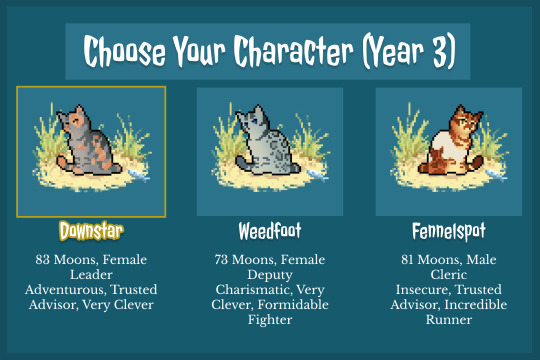

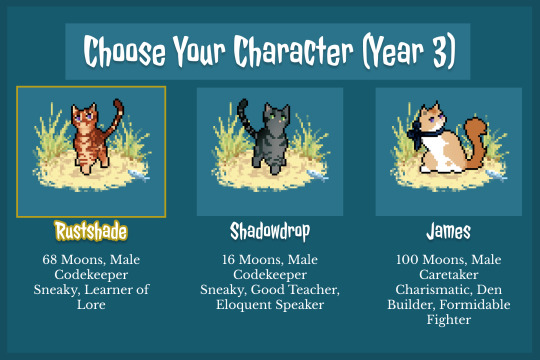

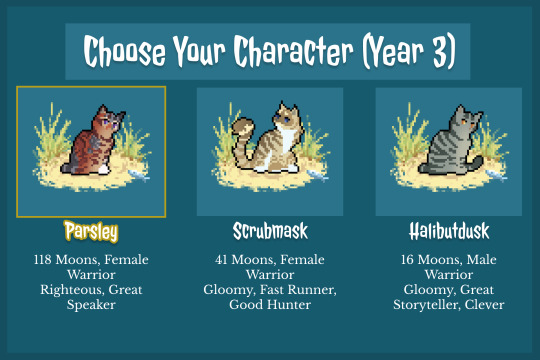

Leader:
Downstar - a gray/pale ginger tortoiseshell molly (83, adventurous, trusted advisor, very clever)
Deputy:
Weedfoot - a rosette silver molly (73, charismatic, very clever, formidable fighter)
Clerics:
Fennelspot - a rosette dark ginger and white tom (81, insecure, trusted advisor, incredible runner)
Artisans:
Rabbitjoy - a golden-brown smoke molly (61, charismatic, master weaver) Apprentice: Rattlepaw
Historians:
Oilstripe - a ginger tabby molly (28, charismatic, ghost sight)
Burdockcreek - a dark ginger tabby tom (18, competitive, lore keeper)
Codekeepers:
Rustshade - a dark ginger tabby tom (68, sneaky, learner of lore)
Shadowdrop - a gray tabby tom (16, sneaky, good teacher, eloquent speaker)
Caretakers:
James - a long-furred, dorsal-striped, pale ginger and white tom (100, charismatic, den builder, formidable fighter)
Carnationspeckle - a brown and white ticked molly (26, compassionate, talented swimmer)
Clammask - a masked golden tabby molly (18, righteous, lore keeper, good teacher)
Graythroat - a gray tabby molly (16, fierce, trusted advisor)
Warriors:
Parsley - a dark ginger/gray and white torbie molly with no tail. (118, righteous, great speaker)
Scrubmask - a long-furred, masked, light brown and white tabby molly (41, gloomy, fast runner, good hunter)
Halibutdusk - a gray tabby tom (16, gloomy, great storyteller, clever)
Apprentices:
Rattlepaw - a furless silver and white moll (7, insecure, plays with prey)
Elders:
Puddlespeckle - a rosette silver tom (150, strict, good hunter, good kitsitter)
Cats Outside The Clans:
Froggy - a long-furred black tabby tom (93, male, rebellious, maintains the territory, great speaker)
25 notes
·
View notes
Text
In this section of Moll Flanders, we see the way the book deals with children- it rushes them out of the way. One of Moll's children will be important later, but for the most part, they go off to live with relatives and she goes on with the rest of her story.
You can look at this from a Doylist or a Watsonian perspective.
From a Doylist perspective, Daniel Defoe wants Moll to keep having adventures while not handicapped by raising children. He makes sure she never abandons them on the street, but that they go somewhere they will be safe and provided for, and then he continues on with the story unless he wants to bring one back for plot later. Perhaps because I'm a Moll apologist (mollpologist?) I tend to read it this way.
From a Watsonian perspective, you could say she knows they'll be happier with guardians who aren't her- or you could see her as James's mom from Derry Girls.
11 notes
·
View notes
Text
Normal People - The Book Stuff
what was read and referenced in the TV series

The Golden Notebook by Doris Lessing

Never Let Me Go by Kazuo Ishiguro

Moll Flanders by Daniel Defoe
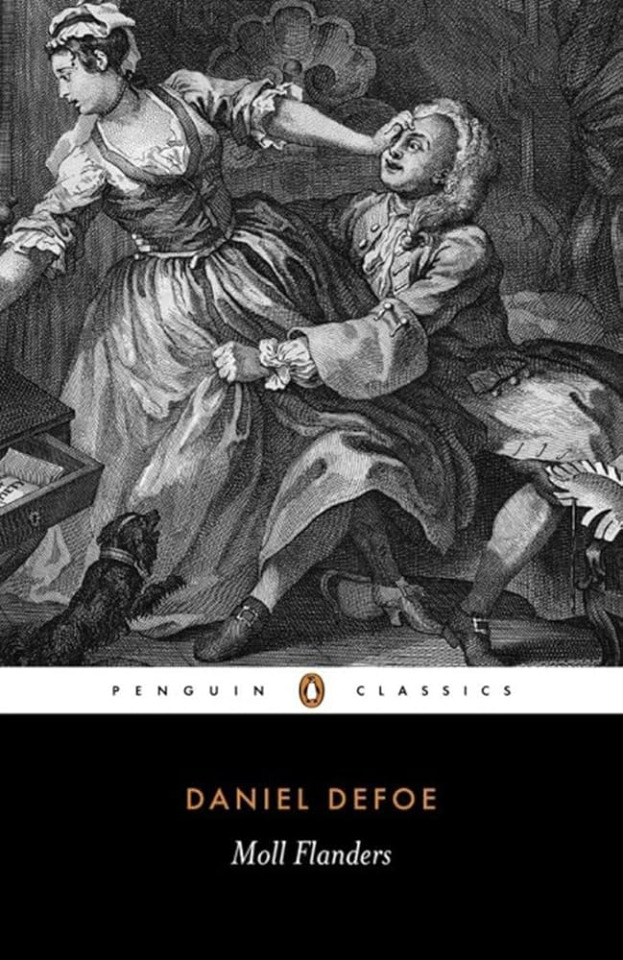
Emma by Jane Austen

The Adventures of Tom Sawyer by Mark Twain

All My Sons by Arthur Miller

Candide, or Optimism by Voltaire
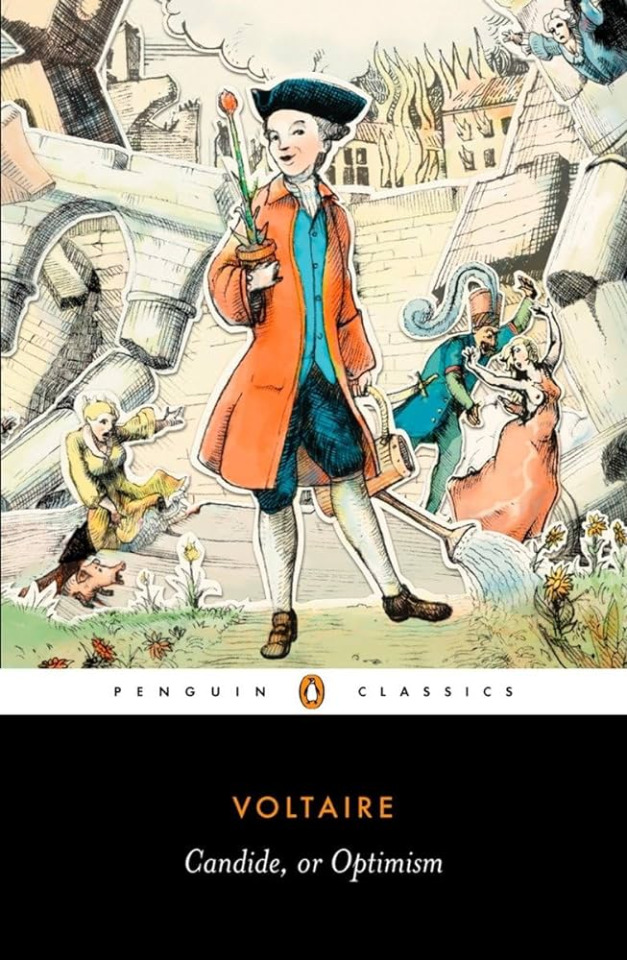
bonus:
Poems by Frank O'Hara
James Joyce
#normal people#sally rooney#normal people series#marianne sheridan#connell waldron#bbc series#books#books on tv#adaptations#classic literature#academia#paul mescal#daisy edgar jones#all the books in normal people#classics#poetry
9 notes
·
View notes
Text
EVILSPEAK (1981) – Episode 263 – Decades Of Horror 1980s
“By the four beasts before the throne. By the fire which is about the throne. By the most holy and glorious name, Satan. I, Stanley Coopersmith will return. I WILL RETURN!” Well, he’s Clint Howard. Of course, he will return! Join your faithful Grue Crew – Crystal Cleveland, Chad Hunt, Bill Mulligan, and Jeff Mohr – as they hang out in the church basement with young Cadet Coopersmith in Evilspeak (1981).
Decades of Horror 1980s Episode 263 – Evilspeak (1981)
Join the Crew on the Gruesome Magazine YouTube channel! Subscribe today! Click the alert to get notified of new content! https://youtube.com/gruesomemagazine
An outcast military cadet taps into a way to summon demons and cast spells on his tormentors through his computer.
Directed by: Eric Weston
Writing Credits: Joseph Garofalo, Eric Weston
Cinematography by: Irv Goodnoff
Selected Cast:
Clint Howard as Stanley Coopersmith
R.G. Armstrong as Sarge
Joe Cortese as Reverend Jameson (as Joseph Cortese)
Claude Earl Jones as Coach
Haywood Nelson as Kowalski
Don Stark as Bubba Caldwell
Charles Tyner as Colonel Kincaid
Hamilton Camp as Hauptman
Louie Gravance as Jo Jo
Jim Greenleaf as Ox
Lynn Hancock as Miss Friedemeyer
Loren Lester as Charlie Boy
Kathy McCullen as Kelly
Lenny Montana as Jake
Leonard D’John as Tony
Bennett James as Captain Merrill (credited as Bennett Liss)
Katherine Kelly Lang as Susie Baker
Richard Moll as Father Esteban
Robert Tafur as Old Priest
Sue Casey as Mrs. Caldwell
Evilspeak answers the question, “What happens when a bullied, military school cadet finds a Satanic tome written in Latin in the basement of the academy chapel?” Of course — with a helping hand from an early Apple PC — shenanigans ensue! Heads are lost, hearts are ripped out, and worst of all… the hogs are released! Yikes! Clint Howard, as Stanley Coopersmith, plays the bullied cadet transformed into a possessed Satanic priest with gusto and is expertly supported by a cast of experienced character actors. The story starts a bit slow, but the Grue-Crew promises you will be rewarded during the final act of Evilspeak. And never fear. The bullies get their just deserts.
At the time of this writing, Evilspeak is available to stream from Shudder, AMC+, and Plex.
Every two weeks, Gruesome Magazine’s Decades of Horror 1980s podcast will cover another horror film from the 1980s. The next episode’s film, chosen by Crystal, will be��Parents (1989), a horror comedy featuring Randy Quaid, Mary Beth Hurt, and young Bryan Madorsky as the Laemles. The question is, what do Mr. And Mrs. Laemle serve for dinner?
Please let them know how they’re doing! They want to hear from you – the coolest, grooviest fans – so leave them a message or comment on the Gruesome Magazine Youtube channel, on the Gruesome Magazine website, or email the Decades of Horror 1980s podcast hosts at [email protected].
Check out this episode!
3 notes
·
View notes
Text
Bell Book And Candle
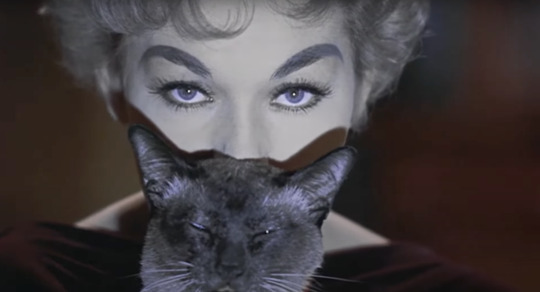
Director Richard Quine Stars James Stewart, Kim Novak, Elsa Lanchester, Jack Lemmon, plus the apparently numerous cats who played Pyewacket USA 1958 Language English 1hr 46mins Colour
Witchy 1950s rom-com
In 1958, James Stewart and Kim Novak starred in Vertigo, which for at least a couple of decades now has been considered by critics as one of the best five or so movies ever made. In 1958, Stewart and Novak also made Bell Book And Candle, which is not widely thought of as one of the greatest works of cinema, but is a film I’ve long been very fond of.
Stewart plays Shep Henderson, a publisher who’s recently moved into a Greenwich Village apartment. On the ground floor, there’s a shop selling tribal masks and statues from around the world (a bit dubious by 2024 standards?) run by a young woman called Gillian Holroyd (Novak). Gillian lives in the building, along with her brother Nicky (Jack Lemmon), aunt Queenie (Elsa Lanchester) and Siamese cat Pyewacket.

Gillian decides she rather likes Shep and thus will get Shep. Gillian is, you see, a witch – all the Holroyds have magical powers, in fact, although only hers are powerful enough to be of any practical use. So we’re off on one of those stories where a character wrestles with the idea of whether using magic to kickstart a relationship is unfair.
There’s a pretty valid reading of ‘magic’ = queerness in this film. It’s adapted from a play by John Van Druten, who was gay, and full of lines like, ‘I have always lived for and by the special. Not the ordinary. Why, I've never even thought of marriage’ and ‘Auntie, don't you ever wish that you weren't – what we are?’ The Holroyds hang out a basement club called The Zodiac with like-minded folk – early on, Shep and his fiancee (Janice Rule) turn up, very much sight-seeing straights.

But equally, it’s by no means obligatory to watch the film through that lens. Gil, Nicky and Queenie could just be classic Greenwich Village bohemians with rare gifts.
My impression has long been that Hollywood never quite figured out what do with Kim Novak. She’s a complicated version of a Hitchcock blonde in Vertigo, but that was her only film with him. Likewise, she made one movie each for Billy Wilder, Otto Preminger and Robert Aldrich. (She made three with Richard Quine, director of this one, but that ended badly too and he's not thought of as belonging in the company of the chaps I just listed.)
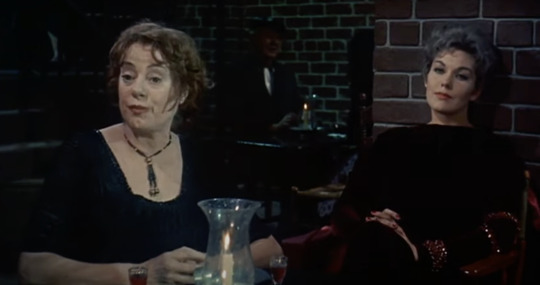
She played an all-American beauty queen, a gangster’s moll, an unhinged movie star, a sex worker at least twice, Moll Flanders… Seems like execs took a look at her body and decided she was right for raunchy roles and I don't think that was the correct conclusion. Bell Book And Candle seems a better fit: she’s cool, hip, a bit weary, a bit schemey, Very much the kind of woman Don Draper would have been involved with, if you’ll allow me a cross-fictional thought.
Novak was only 25 when BB&C was made but the character feels like she’s in her early thirties, maybe? James Stewart turned 50 during shooting and not a young 50, either. Supposedly, after watching Bell Book And Candle he made the wise decision that he wasn’t going to play a romantic lead in movies with actresses half his age anymore. (Which effectively, at that point, meant not playing the romantic lead in Hollywood movies.) Cary Grant, who was four years older, persisted for another five years and then retired completely soon after. I’m glad Grant made Charade and I’m glad Stewart stars in Bell Book And Candle but think he was wise to acknowledge at this point it was looking a bit off.

So why do I like this film so much? A lot of it, I think, comes from the look – it’s a very classy Hollywood imagining of what Beatniks might be like. To me, Gil is one of the best-dressed characters in the history of film (her hair, short slivery blonde with a hint of lavender is cool too, only the greasepaint eyebrows are an issue.)
The colours are terrific – lovely work by the veteran cinematographer James Wong Howe. There’s a nice bit of location shooting (without the characters) in Manhattan that makes the sturdy studio sets feel like they could be the real thing and it really might be snowing.
BB&C is a romantic comedy, but like quite a lot of romcoms, it’s light on big laughs. Most of the funnier scenes involve Ernie Kovacs as a writer of non-fiction books about the supernatural who believes he knows what’s going on at the Zodiac Club. Rather, the film relies on charm and atmosphere. And, fortunately, it has more than enough of both.
3 notes
·
View notes